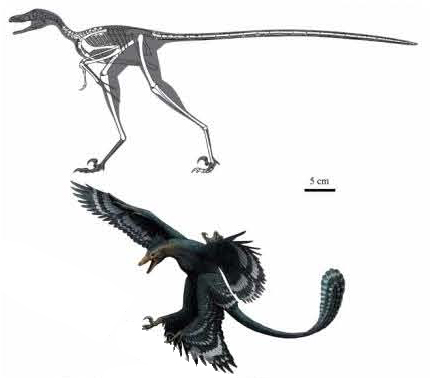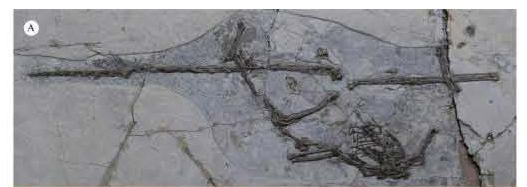New Tiny Dromaeosaurid from the Jehol Biota
Zhongjianosaurus yangi from the Early Cretaceous of China
Researchers from the Chinese Academy of Sciences have published information on-line about the discovery of another dromaeosaurid from the Lower Cretaceous Yixian Formation of Liaoning Province (north-eastern China).
Zhongjianosaurus yangi
The little, long-legged “raptor”, that measured around eighty centimetres in length has been described as looking like “Microraptor on silts”. The dinosaur has been named Zhongjianosaurus yangi, in honour of Yang Zhongjian regarded as the founder of vertebrate palaeontology in China. The forelimbs are nearly as robust as the back legs which is a little unusual. In addition, the ulna (bone in the lower arm), is longer than the humerus (upper arm bone), an anatomical feature that this dinosaur shares with many volant (capable of flight), birds. The forelimb anatomy of Z. yangi contrasts with the anatomy of most non-avian theropods, where the ulna is almost always much shorter than the humerus.
A Skeletal Drawing and an Illustration of Zhongjianosaurus yangi

Zhongjianosaurus fossil material (in white) shown in a skeletal drawing with a scientific illustration below.
Picture credit: Chinese Academy of Sciences
In the skeletal drawing (above) the fossil material assigned to Z. yangi is shown in white. Note the skull has not been found (scale bar equals five centimetres).
Eight Dromaeosaurid Species from the Jehol Group – Niche Partitioning
The dromaeosaurids, which are a group of maniraptoran theropods, are globally distributed and they have left a relatively extensive fossil record, but the earliest representatives of the Dromaeosauridae family come from the Lower Cretaceous Jehol Group of western Liaoning Province. So far, a total of eight dromaeosaurid species have been reported from the Jehol Group, they are remarkably diverse and show numerous differences in their body plans which indicate that each type of dromaeosaurid was adapted to a different habitat or niche in the ecosystem.
This newly described dinosaur, Zhongjianosaurus yangi, classified from a single slab of fossilised bones continues this trend for dromaeosaur diversity. It is many times lighter than the largest dromaeosaurid (Tianyuraptor ostromi), known from this locality. With an estimated 0.31 kilogramme mass, the Z. yangi holotype representing an adult individual, confirms that some Jehol dromaeosaurids are among the smallest known non-avialan theropods described to date.
To view articulated models of dromaeosaurids and other dinosaurs: Beasts of the Mesozoic Articulated Models.
The Holotype Fossil Material (Post-cranial Material) of Z. yangi
Picture credit: Chinese Academy of Sciences
A Member of the Microraptorinae (Zhongjianosaurus yangi)
Zhongjianosaurus yangi has been assigned to the Microraptorinae sub-family and the single fossil specimen was excavated from strata representing lake deposits in Sihedang, Lingyuan County, (western Liaoning). The ninth dromaeosaurid of the Jehol Biota is difficult to date accurately, as Sihedang strata lacks biostratigraphical markers. Z. yangi has been tentatively dated to the Aptian faunal stage of the Early Cretaceous (125 million-years-ago approximately).
Many of the other dromaeosaur fossils have been retrieved from private collections and they subsequently lack stratigraphical context. However, even if all nine different types of dromaeosaurid did not live at the same geological time they certainly represent a very disparate group and this suggests that these little dinosaurs adapted to different habitats and perhaps sources of food (niche partitioning).
Galapagos Finches
As reported in the advanced on-line publication, the researchers, Xing Xu and Zi-Chuan Qin propose that this collection of dromaeosaurids demonstrates niche partitioning and they compare the Jehol Dromaeosaurs to Darwin’s Galapagos finches. Darwin noted that although the finches on the various islands that make up the Galapagos shared a common ancestor, they showed remarkable diversity in beak form and function.
In the absence of cranial material, it is not possible to identify what the tiny Zhongjianosaurus ate, but it is postulated that it could have been an insectivore, perhaps living high up in the tree canopy to escape the fast-running, larger hypercarnivores (other dromaeosaurs), that roamed the forest floor. Zhongjianosaurus was very probably feathered and those robust forelimbs could have supported wings that helped it to glide or flap its way from branch to branch.
The scientific paper: “A New Tiny Dromaeosaurid Dinosaur from the Lower Cretaceous Jehol Group of Western Liaoning and Niche Differentiation Among the Jehol Dromaeosaurids”, by Xing Xu and Zi-Chuan Qin (Chinese Academy of Sciences).
Visit Everything Dinosaur’s website: Everything Dinosaur.


